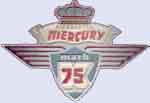The three following pictures is a vintage of one kind of wide clamping system Anzani had. I have no way of knowing whether it was newer or older but it was used as they stripped the original clamping threads in the aluminum castings, so they inserted a threaded brass tube/pipe and rethreaded that to use a Mercs clampdown, handles and washers to do it all over again. This unit is a mixure of cast aluminum and brass that would make it heavier but not too significantly so.
Never the less, the way they build cockpits now and how they used to build some way back when was to fit the drivers width forward and then pull the cockpit in to make it narrow at the back to deal with the mounting space given the motor. Contemporary users of the Anzanis you have seen here earlier would indicated that the narrow mounting with wise of the clamping system was in heavy use and there were situations where the engine would shif loose from pounding and vibrating setting it at a dangerous angle with even one clamp coming off the transom causing some accidents,like I have an old picture somewhere showing Dick Pond having that problem with his Anzani (will find that soon enough for posting). These engines with their heavy duty crankshafts and cast iron loop block were also known for cracking the cast and machined engine mounting torque tube tower at the neck that broke the block loose from the pounding back and forth it took. Some later owner/drivers even reversed the engine mountint to put less loading over the transom putting the cast iron loop block cylinders facing the drivers butt and putting the carb on the right side of the raceboat mount making the block a natural spray shield. Pipes were re-configured and mounted to match the reversal that look some of the strain of the neck to block mount cutting down on the cracking. Some owner drivers did find that the only thing left holding the entire engine to the boat was by its steering bar and ropes with the most recent happening in UK (England) to whom I sent a new tower/tube to replace his broken one as welding proved itself not too reliable leaving the tube okay for displays but that is all. In Roger Wendt's case of his hybrid Anzani they used a fabricated steel tube, Mercury saddle, co-pilot brake and clamps but went to a Konig gearcase to deal with that issue. I have such a cracked tube here, there is now way but for displays after welding for that one.


 Thanks:
Thanks:  Likes:
Likes: 






Bookmarks